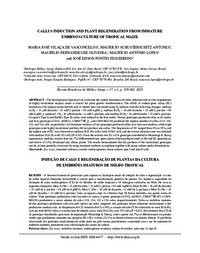Callus induction and plant regeneration from immature embryos culture of tropical maize.
Callus induction and plant regeneration from immature embryos culture of tropical maize.
Author(s): VASCONCELOS, M. J. V. de; ANTUNES, M. S.; OLIVEIRA, M. F. de; LOPES, M. A.; FIGUEIREDO, J. E. F.
Summary: The development of protocols to overcome the current limitations of callus induction and in vitro regeneration of highly recalcitrant tropical maize is crucial for plant genetic transformation. The ability of embryogenic callus (EC) formation of 46 tropical maize hybrids and 14 inbred lines was tested using N6 medium with the following changes: medium A (N6 + 15 µM dicamba + 25 mM L-proline + 88 mM AgNO3), medium B (N6 + 30 µM dicamba + 25 mM L-proline + 88 mM AgNO3), medium C (N6+ 30 µM dicamba + 6 mM L-proline), and medium D (N6+ 30 µM dicamba + 25 mM L-proline). Compact (Type I) and friable (Type II) callus were induced in the four media. Twenty genotypes produced callus in all media, and four genotypes (CO32, AG8012, CMS477BC4F2, and CMS-HGZ10) produced the highest number of callus (114, 134, 131, and 126 calli, respectively). All immature embryos of ten genotypes produced callus in at least one medium, while eight genotypes were highly recalcitrant and they did not produce any callus. The frequencies of EC ranged from 0% to 38%, and the highest rate of EC was observed on medium B (0.40) with a total of 865 calli, and the lowest induction rate was obtained with medium D (0.29) with 555 calli (P= 0.05). From the seventy-two EC of 26 genotypes transferred to Murashige & Skoog regeneration medium, twenty-four (66.7%) differentiated into green plants which produced seeds in R0 and R1 generations, and twelve (33.3%) developed into albino plants. The results demonstrated that the problem of the recalcitrant genotypes can be, at least partially, overcome by using immature embryos as explants together with tissue culture media formulations. Keywords: Zea mays, immature embryos, somatic embryogenesis, tissue culture, type I and type II calli.
Publication year: 2018
Types of publication: Journal article
Unit: Embrapa Maize & Sorghum
Observation
Some of Embrapa's publications are published as ePub files. To read them, use or download one of the following free software options to your computer or mobile device. Android: Google Play Books; IOS: iBooks; Windows and Linux: Calibre.
Access other publications
Access the Agricultural Research Database (BDPA) to consult Embrapa's full library collection and records.
Visit Embrapa Bookstore to purchase books and other publications sold by Embrapa.

